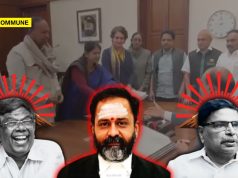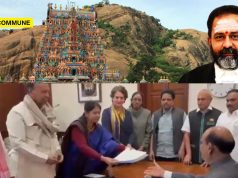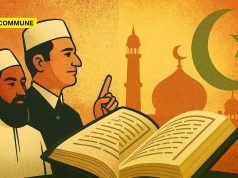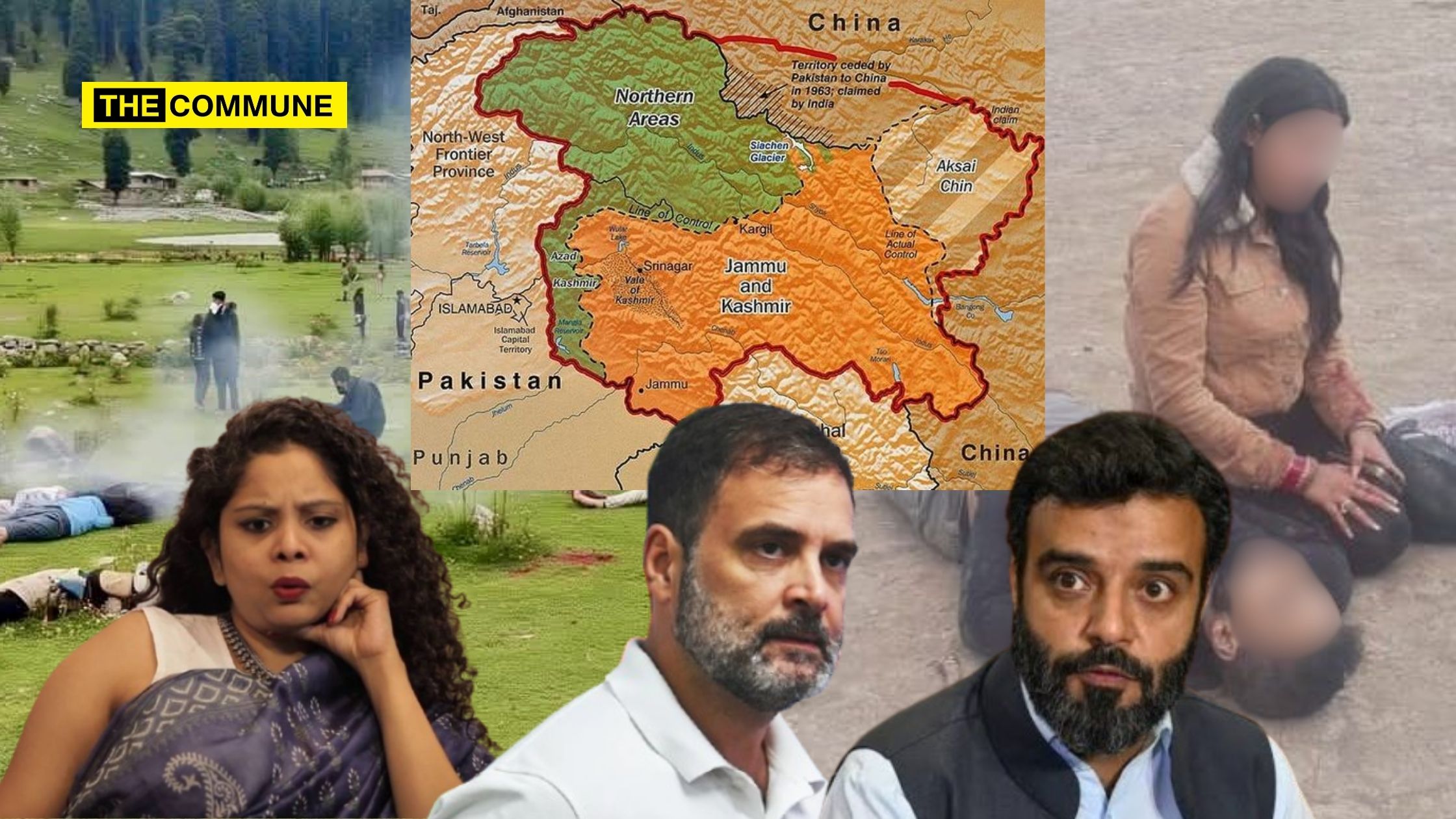
The recent horrific terror attack in Pahalgam that claimed over 26 tourist lives – mainly Hindus, has once again brought Kashmir to a painful crossroads. But beyond the immediate tragedy lies a deeper, more insidious narrative battle—one where Kashmir’s economic renaissance through tourism is being deliberately framed as “colonization” by those who benefited from its isolation -the radical Islamists.
The Tourism Boom: Revival Or “Invasion”?
Since the abrogation of Article 370 in 2019, Kashmir has experienced an unprecedented tourism surge—from fewer than 831,000 visitors in 2018 to a record-breaking 34.98 lakh visitors in 2024. Hotels at capacity, thriving homestays, and bustling markets had finally begun healing Kashmir’s conflict-scarred economy. For ordinary Kashmiris dependent on tourism—taxi drivers, shopkeepers, hoteliers, and artisans—this represented not invasion but survival and a decent living.
Yet curiously, as the valley prospered, a chorus of voices began characterizing this economic lifeline as “cultural invasion” and “settler colonialism.”
The “Colonisation” Rhetoric: Manufactured Victimhood For Separatists
The idea that Kashmir is being “colonised” by Indians—particularly Hindus—hinges on a simple but poisonous assumption: that Islam is the inherent nature of Kashmir, Kashmir does not belong to India, and Indians are foreign to Kashmir.
This is the core logic behind every tweet, every op-ed, and every seminar that calls tourism a threat. It is the same logic that once justified ethnic cleansing of Kashmiri Pandits. It’s the same mindset that legitimized stone pelting, supported “Azadi” sloganeering, and glorified Burhan Wani as a “rebel” rather than a terrorist.
When people call Hindu tourists visiting Kashmir and Hindus moving to Kashmir for business as “colonisation,” they are not being clever—they are revealing the very supremacist mindset that views the Valley as an exclusive Islamist ethno-theocracy.
The Architects of the “Colonization” Narrative
This framing didn’t emerge spontaneously. It has been carefully cultivated by four distinct but overlapping groups:
Separatist Sympathizers: Those who once provided intellectual cover for separatism now repackage their ideology in academic post-colonial jargon. When Maktoob Media’s Rida Fathima describes tourism as “a colonial ploy” and accuses Indian tourists of participating in “occupation,” she’s recycling separatist propaganda in scholarly language.
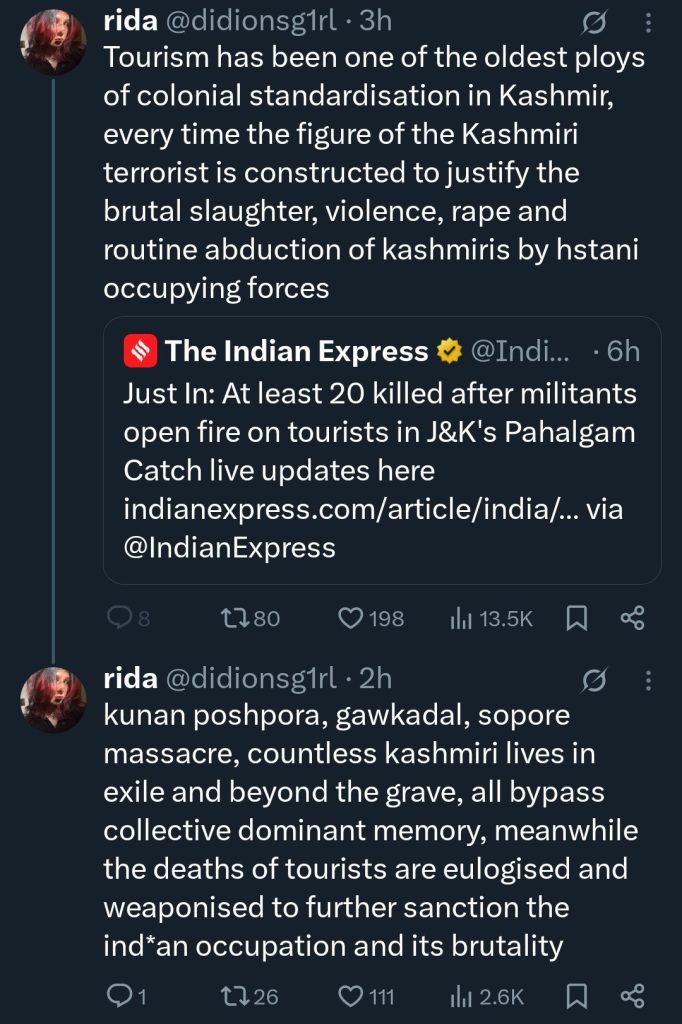
Local Political Elites: Politicians like Aga Syed Ruhullah Mehdi, who characterized tourism as a “cultural invasion,” represent those who thrived under Article 370’s protection. The abrogation stripped away their extraordinary powers and privileges. Their opposition isn’t about protecting Kashmiri culture but preserving political fiefdoms.
Sit down, Ruhullah. https://t.co/Bqm2dU3cDT pic.twitter.com/Weyt4XA2uU
— Amit Malviya (@amitmalviya) April 22, 2025
National Political Elites
Barely months after Congress leader Rahul Gandhi launched his campaign for the Jammu and Kashmir Assembly elections with a promise to “restore statehood” and “empower the people,” terrorists struck in the heart of the Kashmir Valley. Rahul Gandhi should be held accountable for mainstreaming this political rhetoric amid a fragile security environment.
Rahul Gandhi, who addressed back-to-back rallies in Ramban and Anantnag in September 2024, claimed that Jammu and Kashmir is under the rule of a “king” — referring to the Lieutenant Governor — and promised to roll back the current Union Territory status. He framed the removal of Article 370 and the reorganization of J&K as an affront to democracy, ignoring the fact that these measures have led to a significant drop in terror-related incidents over the past five years.
In his 4 September 2024 speech, Gandhi accused the BJP government of “snatching wealth from Kashmiris and giving it to outsiders.” He said, “Not just has your state been snatched away, your rights, your wealth, everything is being snatched away from you. In 1947, we removed Rajas and made a democratic government. We gave Constitution to the country. Today in Jammu Kashmir, there’s a Raja sitting and his name is LG, but he is a Raja. And your wealth is being snatched away from you and given to outsiders. Be it contracts, all the benefits are being enjoyed by outsiders and is being snatched away from Jammu Kashmir people.
On 23 September 2024, he said, “And what was yours, first ‘your’ government used to take decisions, the decisions that were taken in ‘your’ interest, the decisions that were taken in consideration of ‘your’ future, today, ‘people from outside’ are taking decisions. ‘You’ don’t have a voice in running ‘your’government. ‘Your’ government runs from Delhi.”
This rhetoric, critics argue, stokes regional resentment and revives the us-vs-them language that Pakistan-backed terror networks exploit.
This week’s terror strike in Pahalgam reminds the nation of what is at stake. By aggressively championing the rollback of central authority and aligning with parties like the National Conference, which have a long and complicated history with separatist narratives, Rahul Gandhi had effectively signaled to hostile actors — both domestic and cross-border — that a political window may be opening.
Urban “Intellectuals”: Media figures and academics who built careers as Kashmir’s “interpreters” find themselves increasingly irrelevant as the region integrates with mainstream India. Their carefully constructed narratives of perpetual victimhood collapse when Kashmiris prosper under Indian administration.
Radical Islamists: Groups like the self-proclaimed “Kashmir Resistance,” which claimed responsibility for the Pahalgam attack, openly declare war against “outsiders,” revealing the religious exclusivity underlying this rhetoric.
Decoding The Strategy
The “colonization” narrative serves multiple strategic purposes:
First, it delegitimizes economic development. By portraying tourists not as visitors but as invaders, and development not as progress but as erasure, it attempts to make ordinary Kashmiris reject prosperity itself.
Second, it maintains the separatist ecosystem. When a Kashmiri hotelier welcomes Hindu pilgrims, or a shopkeeper befriends Gujarati tourists, the barriers of otherness essential to separatist ideology begin crumbling. Cultural exchange threatens those who profit from division. Add to this the popularity of Hindu shrines in the region – one video circulating on social media shows a lay Muslim calling “idol worship a bigger sin” according to their god when compared to heinous crimes like rape.
Muslims for you pic.twitter.com/1sL656SK5U
— Squint Neon (@TheSquind) April 22, 2025
Third, it provides moral cover for violence. By framing tourists as agents of occupation, it rationalizes attacks like Pahalgam as “resistance” rather than terrorism.
Islamists: The Real Colonizers
Before Article 370 was abrogated in 2019, Kashmir was ruled by a political class that actively excluded Indian laws, stifled women’s rights, blocked land reforms, prevented progressive Indian laws from applying to Kashmir, and redirected development funds into personal coffers while violently suppressed dissenting voices—from Kashmiri Pandits to Balti Shias. These parties treated Kashmir like their fiefdom, while urban elites in Delhi and foreign-funded NGOs provided intellectual cover for this separatism.
This was the real colonisation: the ghettoisation of an Indian state under a religious-political elite that turned the Valley into a hotbed of Wahhabi radicalism.
Where was this outrage when thousands of Kashmiri Pandits were driven out in 1990 with slogans like “raliv, galiv ya chaliv”? Where were the cries of “occupation” then? Why did it take until 2020 for so-called secularists to discover their love for the Kashmiri street vendor, but only when Hindus began returning?
Kashmiri Hindus were the original inhabitants of Kashmir while the invaders were the Islamist Mughals who colonized the region, grew in number, and ultimately threw out the Hindus. Now they cry “colonization”?
What’s Really At Stake
What’s being defended isn’t Kashmiri culture but a political system that enables terrorism that thrives on Kashmir’s isolation. The real fear isn’t cultural erasure but cultural exchange—the possibility that Kashmiris and other Indians might discover their shared humanity through daily interactions.
Kashmir’s development threatens those who need perpetual crisis. A prosperous, peaceful Kashmir renders obsolete the entire intellectual and political infrastructure built around its “special status.” It undermines those who positioned themselves as intermediaries between Kashmir and India and dismantles the grievance industry that provided comfortable careers for many.
The Way Forward
The path ahead must recognize this narrative manipulation for what it is—not a legitimate cultural concern but a calculated strategy. Development and tourism aren’t perfect solutions to Kashmir’s complex challenges, but they create spaces where ordinary Kashmiris can build economic autonomy and engage with India on their own terms, without self-appointed mediators.
True respect for Kashmiri identity comes not from isolation but from enabling Kashmiris to participate fully in India’s economic and cultural life while preserving their unique heritage. This doesn’t require Article 370’s discriminatory provisions but inclusive policies that recognize Kashmir’s distinct character while enabling its full integration.
The greatest threat to those peddling the “colonization” narrative isn’t India’s heavy hand but its open palm – welcoming Kashmir to prosperity rather than perpetual conflict. And that is precisely why they fight so desperately against it.
Subscribe to our channels on Telegram, WhatsApp, and Instagram and get the best stories of the day delivered to you personally.

